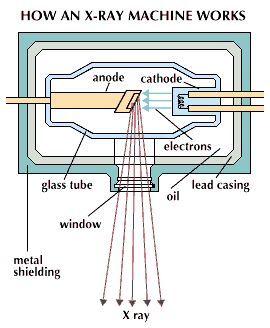How Does Your X-Ray Work?
Have you ever wondered what is going on in your x-ray machine when it makes x-rays? Here is a brief and general explanation that you canuse to answer the questions of the young scientists that sit in your chair. The control box of the x-ray machine does two things. It takes the electrical power that comes from the power company and it controls it so that too much doesn’t get through. This part of the job of the control is called power regulation. The second job of the control is to start the x-ray and stop it in a set period of time. Just like a time keeper in a race the control turns on the switch that starts the x-rays and then after a brief measured amount of time it turns the switch off.

The electricity that the control regulates and times on and off goes to the head of the x-ray where the actual rays are produced. The x-ray tube that is mounted inside the head is like a small dim light bulb with an extra piece of metal at one end. This metal is called tungsten and it has a special property. When tungsten is hit by a high energy electron it takes the energy of the electron and gives the energy back as an x-ray. When the electricity from the control arrives at the head it is split into two jobs. The first job is to light the small dim light. This will be where the electrons come from. The second job is to produce an electric field that will give the electrons the high energy that we want them to have. In the typical dental x-ray the electrons leave the dim light and hit the tungsten metal with an energy of seventy thousand electron volts. The result is an x-ray with enough power to pass through flesh, bone and to a lesser degree teeth and still have enough energy to expose a film or be detected by a digital sensor. The rest of the structure of the x-ray head is for the purpose of absorbing all the stray x-rays and only letting the useful ones out through the cone.